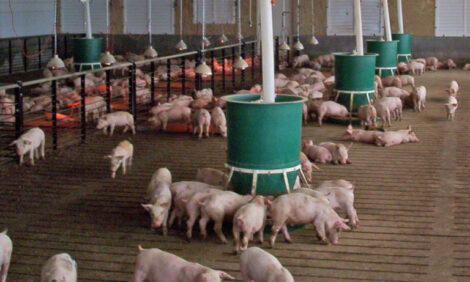



Effects of Transport Duration on the Stress Response and Pork Quality of Pigs
Improvements in truck design and optimisation of handling and transport practices will reduce most of the stress experienced by pigs during long transport, according to a report in the 2011 Annual Report from the Prairie Swine Centre. The study was carried out by J. Brown, Y.M Seddon and H. Gonyou of the Prairie Swine Centre Inc., T. Crowe (University of Sakatchewan), T. Widowski and R. Bergeron (University of Guelph) and L. Faucitano (Agriculture and Agri-Food Canada).

Summary
The impact of the effects of transportation duration, season and
compartments (within trailers) was examined in relation to the
stress physiology of market pigs and pork quality.
Results indicate
transportation of pigs over longer distances producing more significant results. Seasonal differences also indicate that pigs experience
a greater amount of stress in summer months largely due to heat
stress during summer transport. Compartmental differences
indicate some compartments within the trailer produced a greater
amount of stress on market hogs and a reduction in meat quality.
Introduction
The transport of market pigs within Canada presents a number of
significant challenges, including long transport durations and extremes
of temperature. These conditions can cause significant stress
in pigs, which is detrimental to their welfare and may also affect
transit losses and meat quality. It is, therefore, important to understand
factors influencing transport conditions of market pigs within
Canada and how these affect the welfare of pigs and pork quality.
These findings were part of a larger project on the transport of pigs
in Canada. This study examines the effects of transport times of six,
12 and 18 hours on the stress physiology and subsequent meat
quality of pigs transported to slaughter in western Canada, and effects
of season (summer and winter) and compartmental variation
in the truck.
Experimental Procedures
Animals and transport procedures
* "Improvements in truck design and optimization of handling and transport practices will reduce most of the stress experienced by pigs during long transport." |
Over a period of eight weeks (four weeks per season), three transport
trailers were loaded with market pigs (mean live weight 121kg) and transported from a commercial finishing operation to a abattoir.
Each week, prior to leaving for market, 16 focal pigs per truck were weighed, identified with ear tags and given an individual tattoo
number. Feed was withdrawn eight to none hours hours before transport but
water remained available. To study the effect of durations of transport
(six, 12 and 18 hours), three trucks were loaded at six-hour intervals,
with the 18-hour truck leaving the farm at 13:00hr, the 12-hour truck at 19:00hr and six-hour truck at 01:00hr on the day before slaughter.
Timing of loading
was scheduled such that the three trucks arrived at the abattoir at
the same time.
The abattoir was located 300km from the farm, and
longer transport times were achieved by travelling by longer routes
to the abattoir.
Pigs travelled at a density of 0.38 square metres per pig (4 square feet), in
accordance with Canadian Agri-Food Research Council guidelines.
Winter transport took place between January and February (average
temperature -13.4°C) and summer transport between July and
August (average temperature 25.9°C).
In each week, the meat quality
of 48 pigs was studied. These focal pigs were distributed four per
compartment, across four compartments (C) of interest, C1, C4, C5
and C10 (Figure 1).

Focal pigs transported in C1, C4, C5 and C10
Pigs were unloaded at the abattoir and rested in lairage for 1.5 hours with water provided, following which they were driven to an electrical stunner and processed. After evisceration carcasses were chilled (1-4°C) for 24 hours pending cold deboning.
Stress physiology measures
Indicators of physiological stress creatine kinase (CK), cortisol and lactate were measured in 48 pigs per week. Blood was collected at ex-sanuguation. For the measurement of CK and cortisol a minimum of 10mL was collected without anticoagulant. Serum was collected and stored at -80°C until analysis. For lactate, 2mL of blood was collected in tubes containing anticoagulant. These samples were centrifuged and the plasma was stored at -80°C until analysis.
Meat quality measures
Muscle pH and temperature was measured in the longissimus dorsi
(LD) and semimembranosus (SM) muscles at 24 hours postmortem.
Light reflectance (colour) was measured on SM and LD muscles with
a Minolta Chromameter CR 300 (CIE L*, a*, b*) after exposing the
muscle surface to 45 minutes of blooming time.
Drip loss was assessed on an adjacent chop according to a modified EZ-DripLoss procedure
(Correa et al., 2006).
The muscles were classified according to the following quality categories: pale, soft and exudative (PSE), moderate
PSE, red, firm and non-exudative (RFN or normal), pale, firm and
non-exudative (PFN), red, soft and exudative (RSE), moderate DFD
and dark, firm and dry (DFD) as described by Correa et al. (2006).
Results and Discussion
Stress physiology measures
The mean concentration of CK in pigs was affected by compartment
(P<0.001) and the duration of the transport (P<0.05). A significant interaction between the transport duration and the compartment
(Figure 2) indicates significantly higher concentrations of CK occur
when pigs are transported for longer durations (12 and 18 hours), and
when housed in C4 and C10.
As a measure of physical stress (Warris
et al., 1994), these results demonstrate that the longer journeys are
more physically demanding for pigs. The interaction with compartment
demonstrates that some compartments can cause more stress
(C4 and C10), while in others (e.g. C1) pigs travelled long journeys
with no increase in CK.

Where superscripts differ, P<0.05.
Season affected the concentration of cortisol in pigs with levels
being significantly higher during summer than winter (summer:
36.11ng/mL; winter: 27.42ng/mL, P<0.05), suggesting that pigs
experienced a greater amount of stress in the summer months. This
influence of season is most likely due to heat stress during summer
transport, and other studies have frequently observed that more
death losses occur in summer months (Vecerek et al., 2006).
The concentration of lactate in pigs transported in C10 was significantly lower than in the other three compartments (P<0.01). An
interaction between season and compartment showed that in summer, there was no difference in lactate concentrations between pigs
in different compartments. However, in winter, pigs had significantly
higher lactate concentrations when travelling in C1 and C4 (Figure 3).

Where superscripts differ, P<0.05.
Levels of lactate increase in individuals experiencing physical exertion and stress, leading to increased anaerobic glycolysis for the release of energy (Husain et al., 2003). Lactate thus provides a good measure of acute physical stress (Warris et al., 1994). The elevated lactate levels found in compartments C1 and C4, located on the top deck of the trailer, suggest that pigs travelling on the upper decks experienced greater physical exertion during the winter.
Meat quality
Multiple compartment and trip duration effects on meat quality
were found. The longer the duration of travel, the lower the drip loss
observed in C4 and C10, whereas the rate of drip loss did not vary
for pigs transported in C1 or C5. Variation due to the interaction of
compartment and trip length was greatest in C10, with drip loss in
SM muscle being higher following 6 hrs of transport compared to
18 hours.
Within season, pigs travelling in summer in C4 had significantly
lower drip loss than pigs travelling in other compartments. In winter,
pigs travelling in C10 had the lowest drip loss but this was only significantly different from C5.
The variation in drip loss from LD muscle due to compartment and season interactions differed from that in
SM. In LD muscle, there were no significant differences between
compartments in summer. Drip loss in C10 was significantly greater
in summer than in winter, and within winter, drip loss from pigs in
C1 was higher than in any other compartment.
The pH of LD muscle of pigs travelling in C10
for 18 hours was highest compared to any other
compartment (Figure 4). When travelling for six hours, the pH level did not differ between any of the
compartments, while at 12 hours, C4 was significantly higher than C1 and C10.

Where superscripts differ, P<0.05.
The colour (L*) of LD muscle was significantly
darker in C4 and C10 than in C1 and C5, with
C4 and C10 showing moderate DFD characteristics.
The large number of compartment differences
found suggest that improvements to
truck design would aid in improving both the
welfare and meat quality of pigs during long
distance transport.
Conclusions
Evidence from this study shows that the transportation of pigs
over longer durations results in increased physiological stress on
pigs and reduced meat quality, as longer durations (12 and 18 hours)
of transport generally produced more significant results. However,
some compartments showed much greater effects than others. In
particular, compartments C4 and C10 produced results demonstrating
greater stress experienced by the pigs and reduced meat quality,
while C1 and C5 produced fewer effects.
Based on these results, it appears that much of the stress experienced by pigs during long
transports can be ameliorated by improving truck design and optimizing
handling and transport practices.
Some practical conclusions can be drawn from this work related to
handling and transport of pigs. Pigs are highly susceptible to heat
stress in summer, and this can be alleviated by several measures.
The critical time for heat stress to occur is just after loading. Therefore,
loading in hot weather should be done either very early or very
late in the day, and loading documents should be prepared before
loading to ensure speedy departure as air flow is needed to cool the
pigs.
Low stress handling, with minimal prod use, is also necessary
to minimize heat stress. Loading density should also be considered,
and reductions made in high temperatures and at higher marketing
weights. Some truckers will shower pigs before transport, and this can help to alleviate heat stress. However, it should be noted
that showering is only effective if transport begins immediately after
showering, as air flow is needed to achieve evaporative cooling.
Trucks in summer should remain moving for over one hour after leaving
the farm in order to allow pigs to cool.
Stress and meat quality problems associated with winter transport,
while causing fewer death losses, can be argued to be more severe
than in summer months. Adequate boarding and bedding must be
provided, with consideration given to the prevailing wind direction.
Again, loading densities may need to be reduced to allow pigs room
to avoid contact with truck siding.
Future work to improve transport conditions should focus on differences
between compartments, and how to ameliorate the conditions
within problem compartments. For example, studies of air
flow, vibrations and G-forces, and improvements in trailer boarding
patterns and insulation would be useful. Further studies on loading
density are also recommended.
Acknowledgements
Strategic program funding provided by Sask Pork, Alberta Pork, Manitoba Pork Council and the Saskatchewan Agricultural Development Fund. Specific project funding was also provided by Ontario Pork, Maple Leaf Pork, The Natural Sciences and Engineering Research Council, and Agriculture and Agri-food Canada.
August 2012








